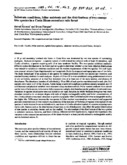Mostrar el registro sencillo del ítem
Substrate conditions, foliar nutrients and the distributions of two canopy tree species in a Costa Rican secondary rain forest
| dc.contributor.author | Herrera, Bernal | |
| dc.contributor.author | Finegan, Bryan | |
| dc.date.accessioned | 2014-10-18T03:29:22Z | |
| dc.date.available | 2014-10-18T03:29:22Z | |
| dc.date.issued | 1997 | es_ES |
| dc.identifier | 353851 | es_ES |
| dc.identifier.uri | https://repositorio.catie.ac.cr/handle/11554/4129 | |
| dc.description | 2 fig. 3 tab. 49 ref. Sum. (En) | es_ES |
| dc.description.abstract | A 28 yr old secondary lowland rain forest in Costa Rica was dominated by two tree species of contrasting ecologies, Vochysia ferruginea - a species typical of well-drained but infertile soils of high AL saturation, and Cordia alliodora, a species requiring soils of at least moderate fertility. The two species exhibited markedly different spatial distributions in the forest and we sought to determine whether or not these different distributions were related to variation in substrate conditions and the nutrient requirements of the two species. Two soil types were present: ultisols (Typic Haplohumults) and inceptisols (Typic Dystropepts) and topography was of low hills. The study formed part of an analysis of site quality for timber production in the two species and therefore used standard forestry methods for such analyses. 36 plots of 20 m X 20 m were established using predetermined criteria of site uniformity, presence of at least four dominant trees of at least one of the study species, and abssence of disturbance. The abundance (number of individuals ó10 cm dbh) of each species was determined in each plot. Soil samples were taken in 27 of the 36 plots, 9 plots being considered to replicate conditions already sampled, and 14 soil chemical and physical variables were measured using standard methods. Foliar nutrients analyses were carried out for trees of both species with crowns fully exposed to sunlight, distributed across the gradient of soil conditions. Variations in species abundances were not related to soil type, but plots in which Vochysia ferruginea was more abundant tended to be on steeper slopes with soils of higher exchangeable acidity and lower concentrations of MN Cordia alliodora was more abundant on gentler topography where soils had much lower exchangeable acidity but higher Mn. Differences between the two species in foliar nutrient concentrations were marked and supported previous interpretations of their nutrient requirements foliar nutrients of Vochysia ferruginea were typical of tree species of moist tropical forest on infertile soils, and those of Cordia alliodora typical of a species requiring more fertile soils. Factors such as the distributions of seed trees at site abandonment: may affect the spatial distributions of tree species in secondary forests such as that studied. The relationships of the distributions of the two species to substrate variation, however, and their evidently different nutrient requirements, support the hypothesis that variation in the composition and structure of the forest studied is at least partially related to exchangeable acidity and its dominant cation, AL. | es_ES |
| dc.language.iso | en | es_ES |
| dc.subject | BOSQUE SECUNDARIO | es_ES |
| dc.subject | BOSQUE TROPICAL HUMEDO | |
| dc.subject | CORDIA ALLIODORA | |
| dc.subject | CUBIERTAS DE COPAS | |
| dc.subject | SUPERFICIE FOLIAR | |
| dc.subject | TIPOS DE SUELOS | |
| dc.subject | SUSTRATOS DE CULTIVO | |
| dc.subject | COSTA RICA | |
| dc.title | Substrate conditions, foliar nutrients and the distributions of two canopy tree species in a Costa Rican secondary rain forest | es_ES |
| dc.type | Artículo | es_ES |
Ficheros en el ítem
Este ítem aparece en la(s) siguiente(s) colección(ones)
-
Publicaciones y documentos [3648]


